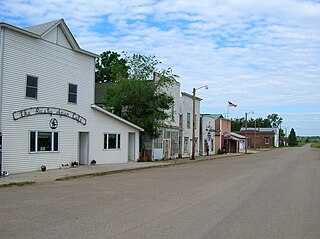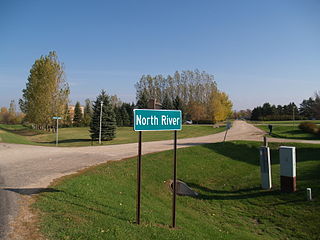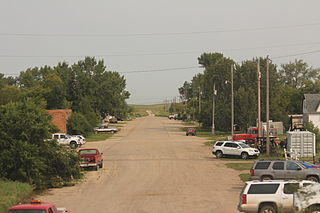
Mountrail County is a county in the northwestern part of North Dakota, United States. As of the 2020 census, the population was 9,809. Its county seat is Stanley. The county was originally created in 1873, then removed in 1892, annexed by Ward County. It was re-created and organized in 1909.

Burke County is a county on the north edge of the U.S. state of North Dakota, adjacent to the south line of Canada. As of the 2020 census, the population was 2,201. The county seat is Bowbells. The county is named after John Burke, the tenth Governor of North Dakota.

Kathryn is a city in Barnes County, North Dakota, United States. The population was 66 at the 2020 census. Kathryn was founded in 1900. It was named after the daughter of a railroad man.

Portal is a city in Burke County, North Dakota, United States. The population was 125 at the 2020 census. Portal was founded in 1893.

North River is a city in Cass County, North Dakota, United States. The population was 55 at the 2020 census. North River was founded in 1973. It is a suburb/bedroom community directly adjacent to the city of Fargo.

Munich is a city in Cavalier County, North Dakota, United States. The population was 190 at the 2020 census. The city was named after Munich, Germany.

Halliday is a city in Dunn County, North Dakota, United States. The population was 241 at the 2020 census. Halliday was founded in 1914.

Elgin is a city in Grant County, North Dakota, United States. The population was 543 at the 2020 census.

Gackle is a city in Logan County, North Dakota, United States. The population was 281 at the 2020 census.

New Town is a city in Mountrail County, North Dakota. The population was 2,764 at the time of the 2020 census, making it the 18th largest city in North Dakota. New Town was platted in 1950 as a replacement site for the residents of Sanish and Van Hook, as these towns were scheduled to be flooded by the creation of Lake Sakakawea, a reservoir to provide water for irrigation.

Palermo is a city in Mountrail County, North Dakota, United States. The population was 125 at the 2020 census.

Parshall is a city lying within the jurisdictional boundaries of the Mandan, Hidatsa, and Arikara Nation. It is located on the Fort Berthold Indian Reservation in Mountrail County, North Dakota, United States. The population was 949 at the 2020 census. Parshall was founded in 1914 by George Parshall, and is the home of the Paul Broste Rock Museum.

Plaza is a city in Mountrail County, North Dakota, United States. The population was 211 at the 2020 census. Plaza was founded in 1906. The business district is built around a central town square, city park or "plaza". A key feature of the plaza is a recently completed large covered gazebo.

Ross is a city in Mountrail County, North Dakota, United States. The population was 95 at the 2020 census.

White Earth is a small City in Montrail County, North Dakota, United States. It is one of the oldest communities in Mountrail County, having been founded in 1887. The population was 100 at the 2020 census. There is a City Hall at White Earth, community center, two churches and a granary; and no other businesses or services.

Hankinson is a city in Richland County, North Dakota, United States. The population was 921 at the 2020 census. Hankinson was founded in 1886. It is part of the Wahpeton, ND–MN Micropolitan Statistical Area.

Belfield is a city in Stark County, North Dakota, United States and only 15 minutes from Theodore Roosevelt National Park. The population was 996 at the 2020 census. Belfield was founded in 1883, and has seen many boom and busts in this oil-rich part of North Dakota. It is part of the Dickinson Micropolitan Statistical Area.

Ryder is a city in Ward County, North Dakota, United States. The population was 108 at the 2020 census. It is part of the Minot Micropolitan Statistical Area. Ryder was founded in 1906.

Ray is a city in Williams County, North Dakota, United States. The population was 740 at the 2020 census.

Tioga is a city in Williams County, North Dakota, United States. The population was 2,202 at the 2020 census.























